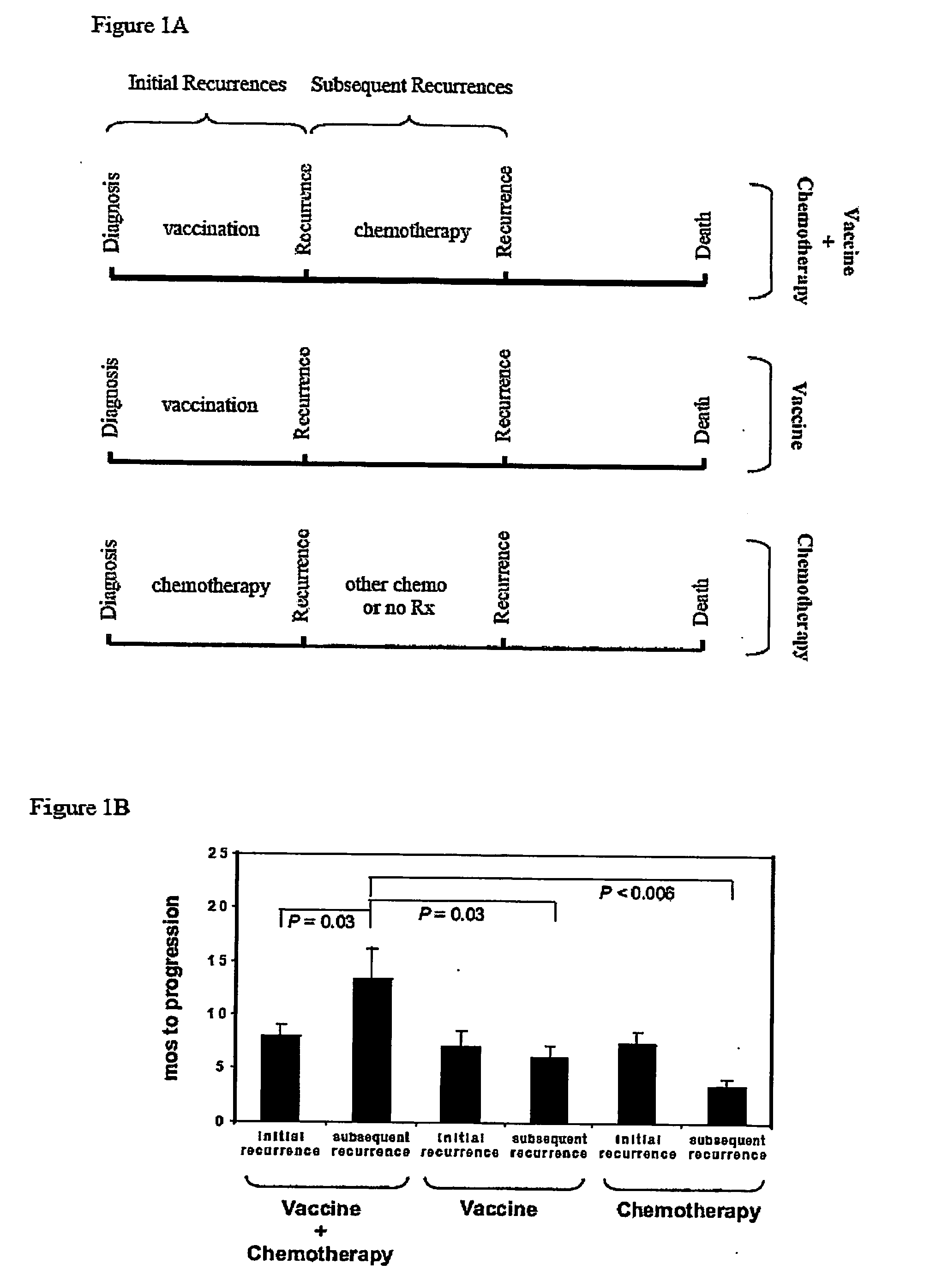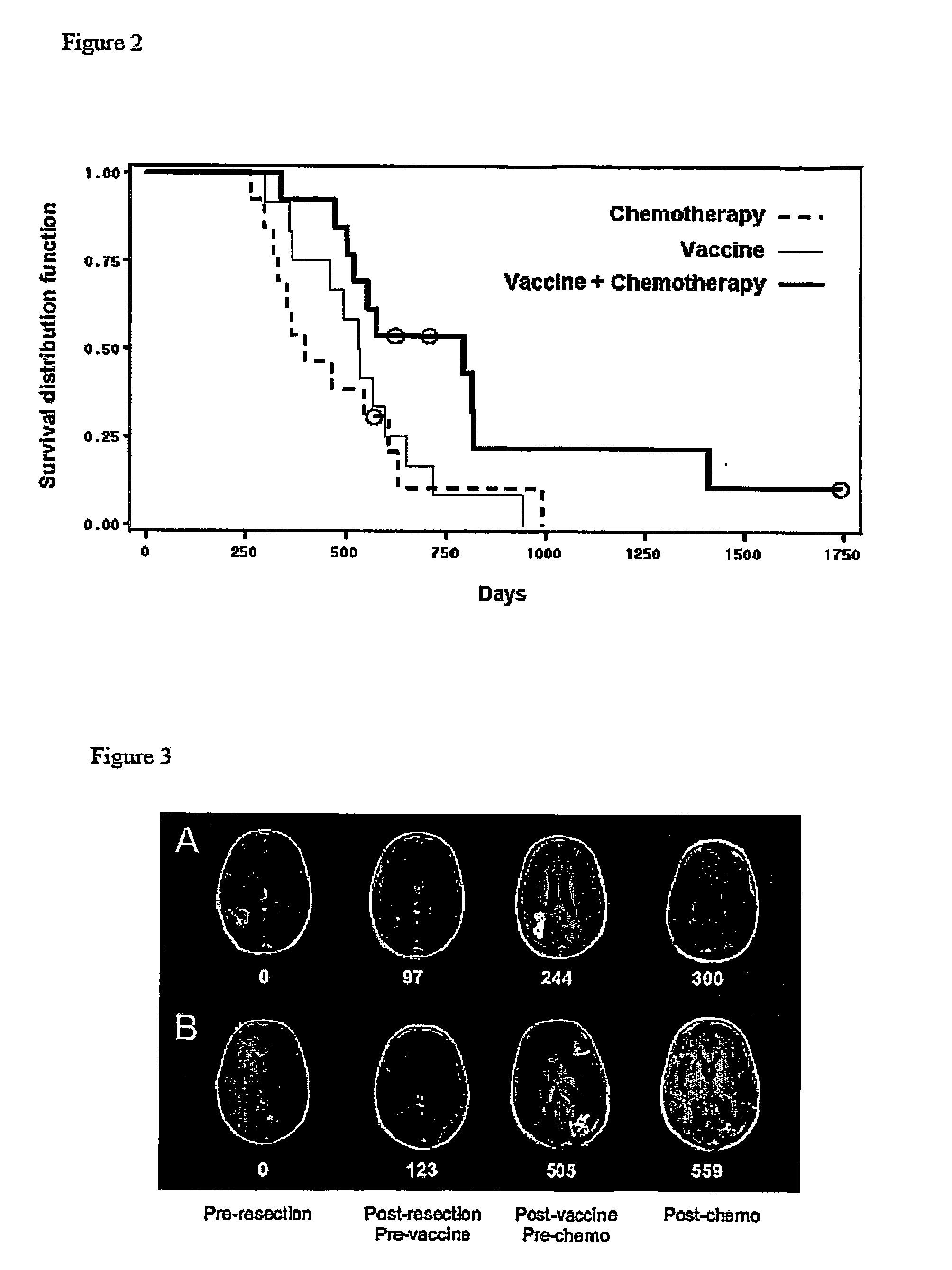System and method for the treatment of cancer, including cancers of the central nervous system
a central nervous system and cancer technology, applied in the field of cancer treatment, can solve the problems of remarkably ineffective conventional therapies at improving the clinical outcome of gbm, the efficacy of therapeutic vaccination for any human tumor remains controversial, and the evaluation of new therapies for this disease is relatively rapid and unequivocal
- Summary
- Abstract
- Description
- Claims
- Application Information
AI Technical Summary
Problems solved by technology
Method used
Image
Examples
example 1
Comparison Among Differentially Treated Patients
[0044] Newly-diagnosed de novo GBM patients (GBM did not arise from malignant progression of initially lower-grade gliomas) were enrolled into one of three vaccine studies or were administered chemotherapy alone, after surgical tumor resection and standard radiation therapy. As indicated in FIGS. 5 and 6, vaccinated (“vaccine” or “vaccine+chemotherapy”) patients received at least three vaccinations with autologous tumor antigen-pulsed DC, starting approximately fifteen weeks post-surgery and five weeks post-radiation therapy, respectively. Patients receiving chemotherapy alone (“chemotherapy” patients) were treated (with surgery, radiation and chemotherapy) over the same time interval as vaccinated patients, as depicted in FIG. 7. Serial MRI scans were performed every 2-3 months in all patients. Tumor progression and overall survival among vaccine, chemotherapy and vaccine+chemotherapy groups were determined and compared, as illustrat...
example 2
Effect of Vaccination on Chemotherapeutic Treatment of GBM Tumors
[0047] To determine if vaccination was capable of eliciting more subtle affects on GBM tumors, the inventors examined whether vaccination could alter GBM sensitivity to subsequent chemotherapy. GBM patients receiving chemotherapy after vaccination enjoyed significantly prolonged tumor progression relative to those receiving vaccination or chemotherapy alone. Similarly, GBM patients receiving chemotherapy after vaccination exhibited significantly prolonged survival relative to those receiving either treatment individually. The possibility that an inadvertent selection bias resulted in inherently slower progressing tumors in patients receiving chemotherapy after vaccination is inconsistent with the statistically identical initial progression times (i.e., after initial vaccination or chemotherapy) among all three groups of patients (“vaccine”, “chemotherapy” and “vaccine+chemotherapy”): tumors behaved the same, clinicall...
example 3
CD8+ TREC Correlation with Increased Tumor Progression Time
[0051] Thymic production of CD8+ T cells is accurately reflected by the concentration of TRECs in purified T cells. See, e.g., D. C. Douek et al., “Assessment of thymic output in adults after haematopoietic stem-cell transplantation and prediction of T-cell reconstitution,”The Lancet, 355:1875 (2000); D. C. Douek et al., “Changes in thymic function with age and during the treatment of HIV infection,”Nature, 396:690 (1998); and B. D. Jamieson et al., “Generation of functional thymocytes in the human adult,”Immunity, 10:569 (1999). Moreover, thymic production of CD8+ T cells accounts for age-dependent glioma prognosis and outcome and predominantly influences vaccine-induced anti-tumor responses in GBM patients. See C. J. Wheeler et al., “Thymic CD8+ T cell production strongly influences tumor antigen recognition and age-dependent glioma mortality,”J. Immunol., 171(9):4927 (2003). The inventors surmised that a direct influence...
PUM
 Login to View More
Login to View More Abstract
Description
Claims
Application Information
 Login to View More
Login to View More - R&D
- Intellectual Property
- Life Sciences
- Materials
- Tech Scout
- Unparalleled Data Quality
- Higher Quality Content
- 60% Fewer Hallucinations
Browse by: Latest US Patents, China's latest patents, Technical Efficacy Thesaurus, Application Domain, Technology Topic, Popular Technical Reports.
© 2025 PatSnap. All rights reserved.Legal|Privacy policy|Modern Slavery Act Transparency Statement|Sitemap|About US| Contact US: help@patsnap.com



